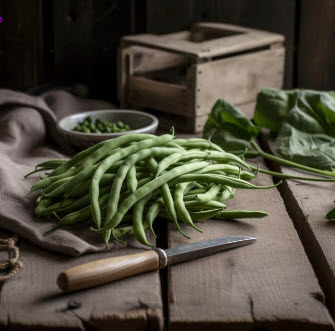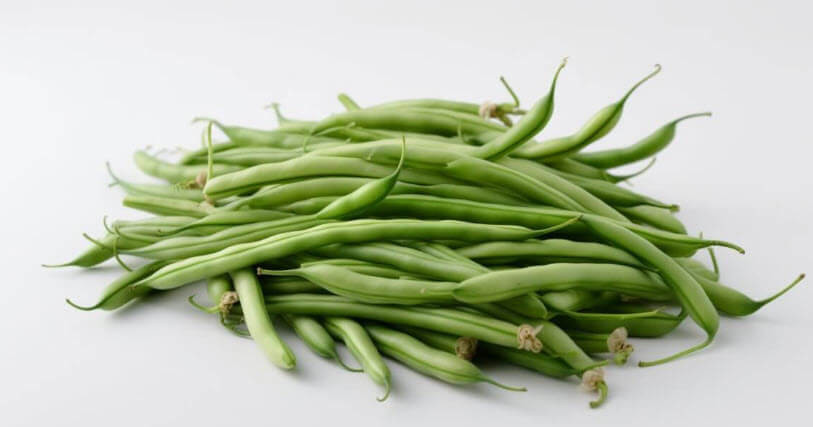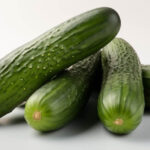Would you prefer to listen to a short podcast discussion about this article? Click on the audio below.
French beans, also known as haricot beans or green beans, are a delicious and nutritious vegetable that is relatively easy to grow. These tasty legumes are an excellent source of vitamins and minerals, and they are also rich in fibre and low in calories, making them an ideal addition to any healthy diet.
Table of Contents
Whether you have a large garden or a small balcony, growing your own French beans is a rewarding experience that can offer you fresh, organic produce throughout the summer months. In this article, we will provide you with a comprehensive guide on how to grow French beans, from selecting the right variety to harvesting and storing your crop.
Introduction to French Beans and their Benefits
What are French Beans?
French beans are a popular vegetable that’s easy to grow. They belong to the same family as runner beans and are native to South America. The beans are picked when they are young and tender, and the pods are eaten whole. They are packed with nutrients such as vitamins A, C, and K, as well as fibre and protein.
Benefits of Growing Green Beans in the UK
Growing your own beans has many benefits. Firstly, you can enjoy fresh and tasty beans straight from your garden. This is not only rewarding but also cost-effective. Secondly, growing your own beans means you have control over how they are grown. You can avoid using pesticides and other chemicals that are commonly used in commercial farming. Lastly, growing beans is a great way to engage in outdoor activities and stay healthy.
Choosing the Right Variety of French Beans
Dwarf or Climbing?
French beans come in two types: dwarf and climbing. Dwarf beans grow to about 45cm in height and do not require any support. Climbing beans, on the other hand, can grow up to 2 meters in height and require support such as trellises, canes, or netting. The choice between the two depends on the availability of space and personal preference.
Popular Varieties
There are many varieties of green beans available in the UK, each with its own unique flavour and characteristics. Some popular varieties to consider include “Cobra,” “Blue Lake,” “Provider,” and “Kentucky Wonder.” These varieties are known for their disease resistance, high yield, and delicious taste.
Preparing the Soil and Planting French Beans
Soil Preparation
The soil should be well-draining and rich in organic matter. To prepare the soil, make sure it is weed-free and then add compost or well-rotted manure. French beans prefer soil with a pH of 6.0 to 7.5, so it’s a good idea to test the soil before planting.
Planting Bean Seeds
Sow the seeds directly into the soil after the last frost when the soil has warmed up. The seeds should be sown 5cm deep and 25cm apart. Water the seeds gently and keep the soil moist until the seedlings emerge.
Planting Bean Seedlings
If you prefer to start with seedlings, plant them outside after the last frost in rows 45cm apart and 25cm apart within the row. Water gently and keep the soil moist until the plants establish.
Watering, Fertilizing, and Maintenance
Watering
French beans need regular watering, especially during dry spells. Water them deeply once a week, making sure the soil is moist but not saturated.
Fertilizing
French beans do not require a lot of fertilizers, but they benefit from a nitrogen-rich fertilizers such as blood, fish, and bone. Apply it once before planting and again when the plants begin to flower.
Staking and Supporting
Climbing French beans need support to grow, and it’s best to put the support in place at the time of planting. A trellis or teepee made from bamboo canes or netting will provide support.
Pruning
Pruning is not necessary for French beans, but it can help to improve airflow and prevent disease. Pinch out the tips of the plants when they reach the desired height to encourage bushier growth. Remove any damaged or diseased leaves or pods as soon as you see them.
Pest and Disease Control
When it comes to growing your beans, you’ll want to keep an eye out for potential pests and diseases that can damage your plants. Prevention is key, so here are some common pests and diseases you should be aware of, along with some tips on how to prevent and treat them.
Common Pests Affecting Beans
One of the most common pests affecting French beans is the black bean aphid. These small, black insects feed on the plant’s sap, causing the leaves to become distorted and yellow. Another pest to watch out for is the bean weevil, which can cause damage to the roots and leaves of the plant.
Common Diseases Affecting Beans
French beans are also susceptible to diseases such as bean rust, which causes yellow spots on the leaves and can eventually lead to defoliation. Another disease to watch out for is powdery mildew, which can cause a white powdery coating on the leaves.
Preventing and Treating Pest and Disease Problems
Prevention is key when it comes to pest and disease control. Make sure to plant your beans in well-draining soil and avoid overwatering. Additionally, you can use natural remedies such as insecticidal soap or neem oil to help control pests. If you do notice signs of disease, remove and dispose of any affected plant material immediately.

Harvesting and Storing Beans
Once your French bean plants start producing, it’s time to harvest! Here are some tips for when and how to harvest your beans, as well as how to store them.
When to Harvest French Beans?
Most French bean varieties will be ready for harvest about two months after planting. Look for beans that are firm and crisp, with a bright green colour. It’s best to harvest your beans before they become too large and tough.
How to Harvest French Beans?
Harvesting French beans is easy – simply snap off the bean from the plant using your fingers or shears. Try to avoid pulling on the plant too much, as this can damage the roots.
Storing Fresh Beans
Fresh French beans should be stored in the refrigerator and consumed within a few days for the best quality. To extend their shelf life, you can blanch them in boiling water for a few minutes and then freeze them for later use.
Tips for Successful Bean Cultivation
Here are some additional tips to help you successfully cultivate French beans.
Choosing the Right Location
French beans thrive in a sunny location with well-draining soil. Make sure to choose a spot in your garden that gets at least six hours of sunlight per day.
Companion Planting with French Beans
Companion planting can help deter pests and improve the health of your French bean plants. Consider planting them near herbs such as basil or marigolds, which can help repel pests.
Dealing with Weather Challenges
In the UK, the weather can be unpredictable, so it’s important to be prepared. If a late frost is expected, cover your plants with a frost cloth. If there is a heatwave, make sure to water your plants regularly to prevent them from drying out. Growing French beans is a fun and rewarding activity that can provide you with fresh and healthy produce right in your backyard.
With the right conditions and care, you can harvest a bountiful crop of delicious French beans each summer. By following the tips and guidelines in this article, you can get started on cultivating your own French beans in no time and enjoy the many benefits they provide.
FAQ
Can French beans grow in pots or containers?
Yes, French beans can be grown in pots or containers as long as they are of sufficient size (at least 12 inches deep and wide) and have good drainage. Make sure to use a high-quality potting mix and provide your plants with adequate water and nutrients.
When should I plant French beans?
The best time to plant French beans in the UK is from mid-April to late June, once the threat of frost has passed and the soil has warmed up. Planting earlier than this can result in poor germination and stunted growth.
How often should I water my French beans?
French beans need regular watering, especially during dry spells. Water deeply once or twice a week, making sure the soil stays consistently moist but not waterlogged. Avoid overhead watering, which can promote disease.
How do I prevent pests and diseases from affecting my beans?
To prevent pests and diseases from affecting your French beans, make sure to plant them in well-draining soil, avoid overcrowding, keep the area clean and free of debris, and provide good air circulation. You can also use natural pest control methods such as companion planting, handpicking, and using organic sprays.
If you are keen on organic gardening, check out The Soil Association website
If you need any further information or assistance with this article, don’t hesitate to Contact Us




















